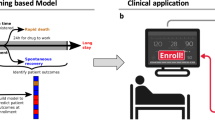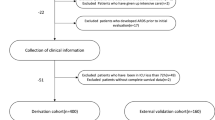Abstract
The acute respiratory distress syndrome (ARDS) is a frequent type of respiratory failure observed in intensive care units. The Berlin classification identifies three severity levels of ARDS (mild, moderate, and severe), but this classification is under controversy in the medical community because it reflects neither the care requirements nor the expected clinical outcome of the patients. Here, the database MIMIC III (MetaVision) was used to investigate the similarity of patients within each one of the Berlin severity groups. We also ranked the relevance of common ARDS descriptive features and proposed four alternative classifiers to improve Berlin’s classification in the prediction of the duration of mechanical ventilation and mortality. One of these classifiers proved to be significantly better than current proposals and, therefore, it can be considered as a robust model to potentially improve health care processes and quality in the management of ARDS patients in Intensive Care Units (ICUs).
Access this chapter
Tax calculation will be finalised at checkout
Purchases are for personal use only
Similar content being viewed by others
Notes
- 1.
During the fold-cross validation, the statistical/machine learning method to produce the model may consider not to use all the features, but only some of them.
References
Rezoagli, E., Fumagalli, R., Bellani, G.: Definition and epidemiology of acute respiratory distress syndrome. Ann. Transl. Med. 5(14), 282 (2017)
Bellani, G., et al.: Epidemiology, patterns of care, and mortality for patients with acute respiratory distress syndrome in intensive care units in 50 countries. JAMA 315, 788–800 (2016)
Ranieri, V.M., Rubenfeld, G.D., Thompson, B. T., et al.: Acute respiratory distress syndrome: the Berlin definition. JAMA 307(23), 2526–2533 (2012). ARDS Definition Task Force
Pirracchio, R., Gropper, M.A.: Heterogeneity in intensive care: low severity does not mean low risk! Anesthesiology 130(2), 190–191 (2019)
Johnson, A.E.W., et al.: MIMIC-III, a freely accessible critical care database. Sci. Data 3, 160035 (2016)
Kira, K., Rendel, L.A.: A practical approach for feature selection. In: 9th International Proceedings on Workshop on Machine Learning, pp. 249–256. Morgan Kaufmann Publishers Inc., Aberdeen (1992)
Malohlava, M., Candel, A.: Gradient Boosting Machine with H2O, 7th edn. H2O.ai, Inc., Mountain View, CA (2018). http://h2o-release.s3.amazonaws.com/h2o/master/4297/docs-website/h2o-docs/booklets/GBMBooklet.pdf
Fan, E., Brodie, D., Slusky, A.S.: Acute respiratory distress syndrome. advances in diagnosis and treatment. JAMA 319(7), 698–710 (2018)
Taoum, A., Mourad-Chehade, F., Amoud, H., Chkeir, A., Fawal, Z., Duchêne, J.: Data fusion for predicting ARDS using the MIMIC II physiological database. In: IEEE 18th International Conference on e-Health Networking, Applications and Services, Munich, pp. 288–292 (2016)
Villar, J., et al.: Age, PaO2/FiO2, and plateau pressure score: a proposal for a simple outcome score in patients with the acute respiratory distress syndrome. Crit. Care Med. 44(7), 1361–1369 (2016)
Bernard, G.R., et al.: The American-European consensus conference on ARDS. definitions, mechanisms, relevant outcomes, and clinical trial coordination. Am. J. Respir. Crit. Care Med. 49(3 Pt 1), 818–824 (1994)
Jia, X., Malhotra, A., Saeed, M., Mark, R., Talmor, D.: Risk factors for ARDS in patients receiving mechanical ventilation for >48 h. Chest 133(4), 853–861 (2008)
Ke, G., et al.: LightGBM: a highly efficient gradient boosting decision tree. In: Advances in Neural Information Processing Systems, pp. 3149–3157 (2017)
Boulesteix, A.L., Janitza, S., Kruppa, J., Konig, I.R.: Overview of random forest methodology and practical guidance with emphasis on computational biology and bioinformatics. Wiley Interdisc. Rev. Data Min. Knowl. Disc. 2(6), 493–507 (2012)
Vapnik, V., Vashist, A.: A new learning paradigm: learning using privileged information. Neural Netw. 22(5), 544–557 (2009)
Lee, J., Scott, D.J., Villarroel, M., Clifford, G.D., Saeed, M., Mark, R.G.: Open-access MIMIC-II database for intensive care research. In: Annual International Conference of the IEEE Engineering in Medicine and Biology Society (2011)
Taoum, A., Mourad-Chehade, F., Amoud, H., Fawal, Z.: Predicting ARDS using the MIMIC II physiological database. In: IEEE International Multidisciplinary Conference on Engineering Technology (2016)
Taoum, A., Mourad-Chehade, F., Hassan, A., Chkeir, A., Fawal, Z., Duchene, J.: Data fusion for predicting ARDS using the MIMIC II physiological database. In: IEEE 18th International Conference on e-Health Networking, Applications and Services (2016)
Fuchs, L., et al.: The effect of ARDS on survival: do patients die from ARDS or with ARDS? J. Intensive Care Med. 34(5), 374–382 (2019)
Wang, T., Tschampel, T., Apostolova, E., Velex, T.: Using latent class analysis to identify ARDS sub-phenotypes for enhanced machine learning predictive performance (2019). https://arxiv.org/abs/1903.12127
Wang, B., Gong, Y., Ying, B., Cheng, B.: Relation between red cell distribution width and mortality in critically ill patients with acute respiratory distress syndrome. BioMed. Res. Int. 2019, 8 (2019). https://doi.org/10.1155/2019/1942078. Article no. 1942078
Acknowledgements
The authors acknowledge financial support from the RETOS P-BreasTreat project (DPI2016-77415-R) of the Spanish Ministerio de Economia y Competitividad.
Author information
Authors and Affiliations
Corresponding author
Editor information
Editors and Affiliations
Rights and permissions
Copyright information
© 2019 Springer Nature Switzerland AG
About this paper
Cite this paper
Sayed, M., Riaño, D. (2019). Modelling ICU Patients to Improve Care Requirements and Outcome Prediction of Acute Respiratory Distress Syndrome: A Supervised Learning Approach. In: Marcos, M., et al. Artificial Intelligence in Medicine: Knowledge Representation and Transparent and Explainable Systems. KR4HC TEAAM 2019 2019. Lecture Notes in Computer Science(), vol 11979. Springer, Cham. https://doi.org/10.1007/978-3-030-37446-4_4
Download citation
DOI: https://doi.org/10.1007/978-3-030-37446-4_4
Published:
Publisher Name: Springer, Cham
Print ISBN: 978-3-030-37445-7
Online ISBN: 978-3-030-37446-4
eBook Packages: Computer ScienceComputer Science (R0)




